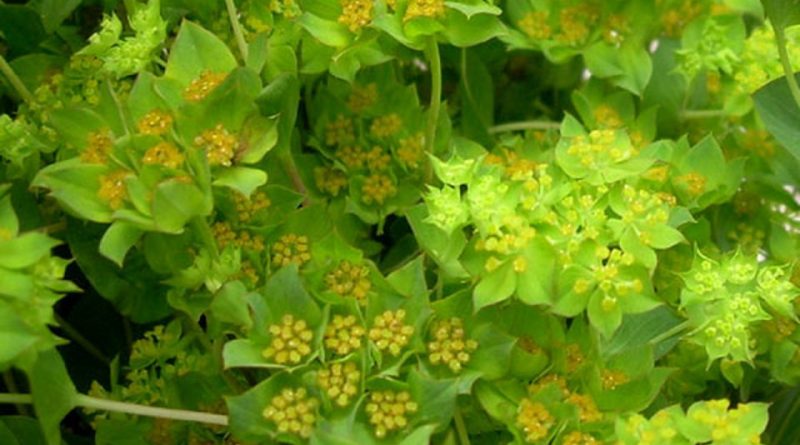Bupleurum rotundifolium
Bupleurum rotundifolium
The Bupleuro perfoliate (Bupleurum rotundifolium L.) is a herbaceous species belonging to the Apiaceae family.
Systematic –
From a systematic point of view it belongs to the Eukaryota Domain, Plantae Kingdom, Spermatophyta Superdivision, Magnoliophyta Division, Magnoliopsida Class, Rosidae Subclass, Apiales Order, Apiaceae Family, Apioideae Subfamily, Bupleureae Tribe and therefore to the Genus Bupleurum and to the Species B. rotundifolium.
The terms are synonymous:
– Bupleurum marginatum Noe ex H. Wolff;
– Bupleurum minus Pampan .;
– Bupleurum perfoliatum Lam .;
– Diatropa rotundifolia (L.) Dum .;
– Perfoliata rotundifolia (L.) Fourr .;
– Perfolisa obtusifolia Rafin .;
– Selinum perfoliatum (Lam.) EHL Krause;
– Bupleurum perfoliatum var. rotundifolium (L.) Desv.
– Tenoria rotundifolia (L.) Bubani.
Etymology –
The term Bupleurum comes from the Greek βούπλευρος boupleuros, name of a plant in Nicandro, derived from βοῦς bous bue and from πλευρά pleurá rib or rib: ox rib, reference to the pronounced leaf veins.
The specific epithet rotundifolium comes from round rotundus and folium leaf: with rounded leaves.
Geographical Distribution and Habitat –
The Bupleuro perfoliate is an annual plant of Asian origin which we have an ancient introduction following the spread of crops (archaeophyte), present in all regions of Italy except in Puglia, but generally rare and inconstant.
It grows as a pest in cereal crops on clayey soils rich in carbonates, from sea level to the lower mountain belt (1200 m. Above sea level), with optimum in the sub-Mediterranean belt.
Description –
The Bupleurum rotundifolium is an annual herbaceous plant, hermaphrodite, 20-50 cm tall, glabrous, glaucous with erect, cylindrical stems, branched at the top.
The leaves are undivided, with the inferior, elliptical-long ones attenuated at the base or embracing the stem and the upper ones, broadly oval-suborbicular perfoliated, all with full margins, with very marked radial ribs, of a glaucous green color, sometimes tinged with violet .
The inflorescence is umbel made up of 5-8 (3-10) rays without involucral bracts. Envelope with 5-6 bracts, wide, oblanceolate, cuspidate that envelop and exceed the umbrellas, the small flowers with 5 free petals are yellowish and revolved inside.
The antesis is in the period of May – June
The fruit is an ovoid polachenary, slightly laterally compressed, smooth with 2.5-4 x 1-1.5 mm mericarpi, oblong or oblong elliptic, smooth, with thread-like ribs, smooth, imperceptible vitta. Seeds with flat endosperm in the commissural face.
Cultivation –
The bupleurum rotundifolium is a self-fertile hermaphrodite plant that adapts to growing in clayey soils rich in carbonates and which, under optimal conditions, can become a pest in cereal crops.
Uses and Traditions –
The Bupleuro perfoliate , also known as Bupleuro with round leaves or Bupleuro with ox lung is the first plant of this genus of which there are precise documents. It is an annual species common in the cultivated fields of southern Europe. In ancient times it was considered a vulnerable plant with an astringent effect.
The leaves contain tannic substances, mucilages, bitter principles, resin and salts. They have a vulnerable and astringent action.
It is, however, little known and little used.
Method of Preparation –
The leaves of this plant can be eaten raw or cooked, added to salads or used as a pot plant.
The leaves are also used as a spice.
Guido Bissanti
Sources
– Acta Plantarum – Flora of the Italian Regions.
– Wikipedia, the free encyclopedia.
– Treben M., 2000. Health from the Lord’s Pharmacy, Tips and experiences with medicinal herbs, Ennsthaler Editore
– Pignatti S., 1982. Flora of Italy, Edagricole, Bologna.
– Conti F., Abbate G., Alessandrini A., Blasi C. (edited by), 2005. An annotated checklist of the Italian vascular flora, Palombi Editore.
Warning: Pharmaceutical applications and alimurgical uses are indicated for information purposes only, they do not in any way represent a medical prescription; therefore, no responsibility is accepted for their use for healing, aesthetic or food purposes.


